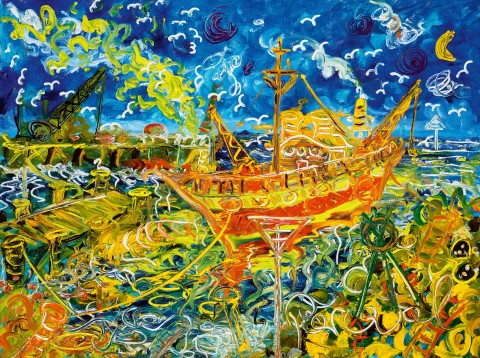SEAGULLS AND SULPHUR SMOKE AT WILLIAMSTOWN, 1990
JOHN PERCEVAL
oil on canvas
91.5 x 122.0 cm
signed lower right: Perceval
signed, dated and inscribed with title verso: SeaGULLS / AND / SULPHUR / SMOKE / AT / WILLIAMSTOWN / Perceval / ‘90
Australian Galleries, Melbourne (label attached verso, stock no. 7804)
Private collection, Melbourne
Joseph Brown Gallery, Melbourne
The Cbus Collection of Australian Art, Melbourne, acquired from the above on 10 September 1998
Recent Paintings, Drawings and Pastels by John Perceval, Australian Galleries, Sydney, 9 – 26 April 1991, cat. 1 (illus. on front cover of exhibition catalogue)
Morning, Noon and Night, Latrobe Regional Gallery, Victoria, 13 July – 13 October 2019
on long term loan to Newcastle Art Gallery, New South Wales, prior to 2006
on long term loan to Gippsland Art Gallery, Victoria
Nainby, B., Stanhope, Z., and Furlonger, K., The Cbus Collection of Australian Art, in association with Latrobe Regional Gallery, Melbourne, 2009, pp. 18, 151 (illus.), 229
John Perceval first encountered the shambolic, working port of Williamstown in the company of Charles Blackman in the mid-1950s, and the experience inspired three renowned cycles of painting. The first formed the core of his inaugural solo exhibition held in 1956 at then newly opened Australian Galleries in Melbourne, with Blackman describing his colleague as being ‘a wonderfully ecstatic painter… very free and very beautiful.’1 The second sequence, dated between 1967 and 1968, echoed the palette and technique of its predecessor, but the third series, which began in 1987 and of which Seagulls and sulphur smoke at Williamstown, 1990 is a key example, is distinguished by its bold use of colour, calligraphic swirls and an enduring sense of optimism. One reason for such renewed vigour was the fact that Perceval was celebrating the end of ten ‘lost’ years, predominantly spent being treated for schizophrenia in Larundel psychiatric hospital in Melbourne’s northern suburbs. In 1984, a retrospective of his work was held at Heide to great acclaim, and two years later, an exhibition of 48 of his drawings sold out in minutes. The subsequent media attention motivated him to return to easel painting.
With the assistance of carers, Perceval was able to re-visit Williamstown, and he found the dock was still as shabby as three decades prior. Working back in his studio on paintings such as Seagulls and sulphur smoke at Williamstown, he celebrated the grand beauty that lurked amidst the detritus by portraying, for example, the rusted surfaces of the old boats in exuberant bursts of yellow and orange. His treatment here of the water’s reflections is similarly effective with whorls of paint snaking through the surface. Perceval’s use of sulphureous yellow for the smoke contrasts brightly against the deep blue of the sky, and the overall composition is held together tightly by the final layer of white paint squeezed directly from the tube. These trails end emphatically with the artist’s enlarged signature at bottom right, a bold statement of authorship that speaks volumes regarding Perceval’s personal satisfaction with this painting, whilst simultaneously declaring his own survival after so many dark years.
1. Shapcott, T., The Art of Charles Blackman, Andre Deutsch, London, 1989, p.23
ANDREW GAYNOR
